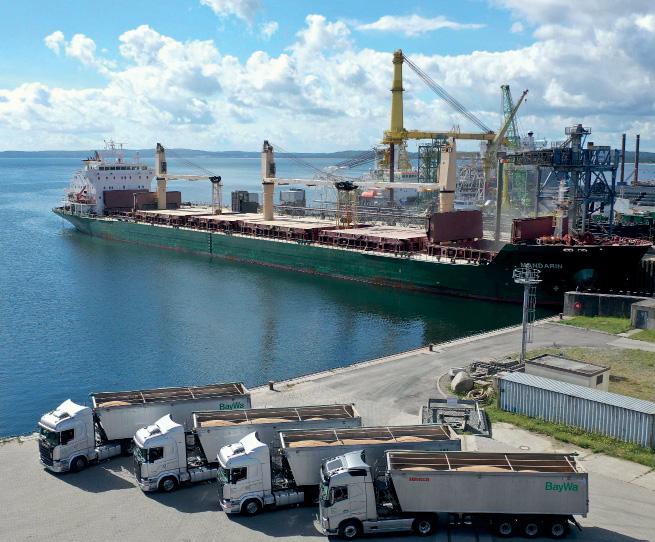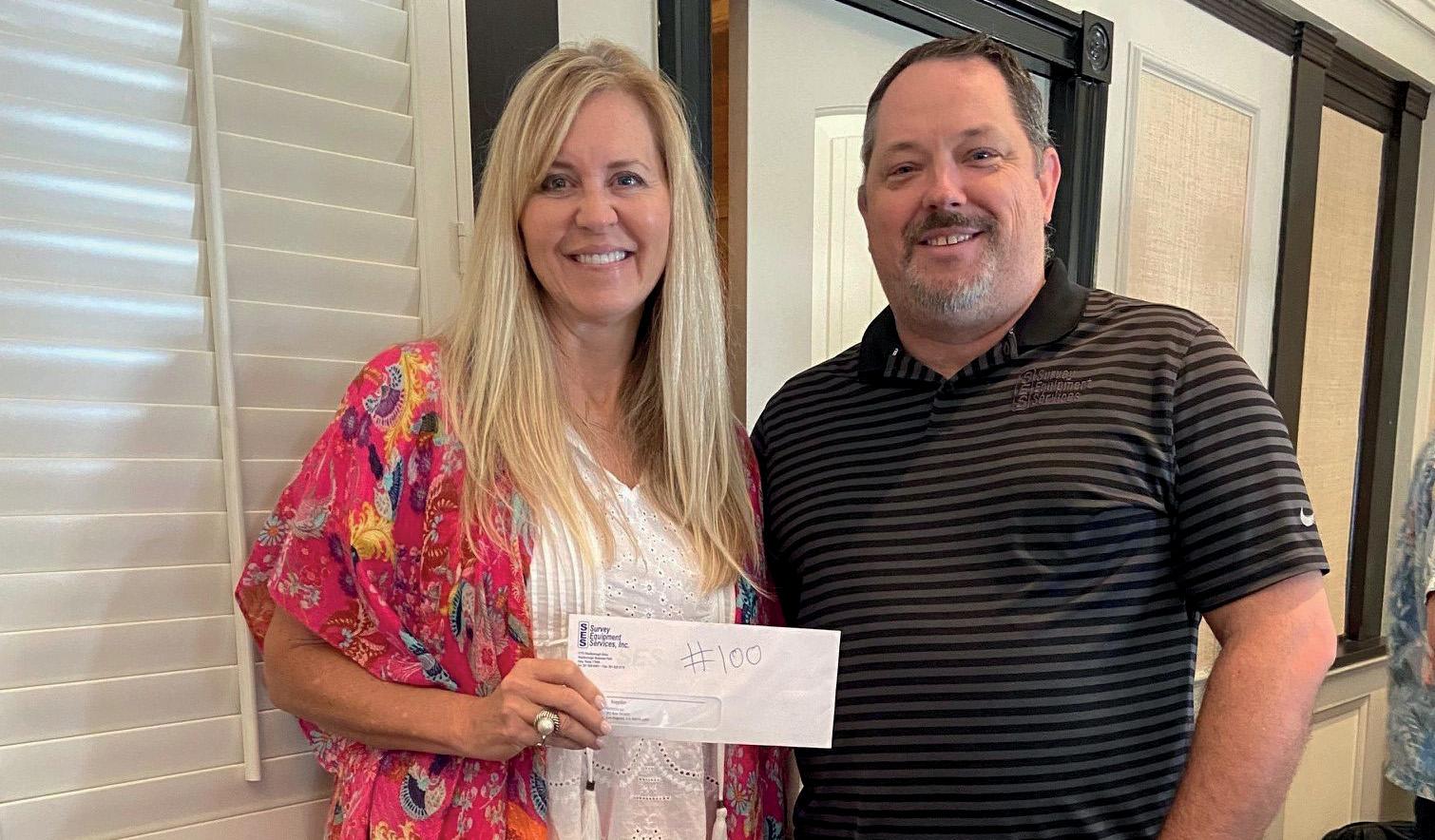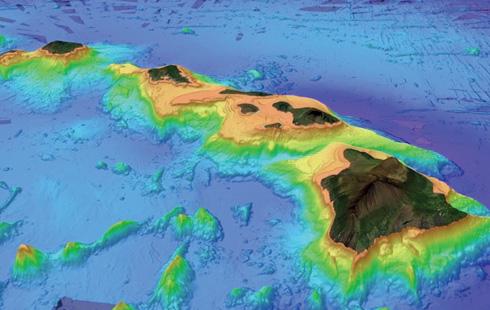
5 minute read
Baltic expansion
NEW DEEP-WATER HUB FOR GERMAN BALTIC PORT
A two-phase project to expand the port of Mukran into an international deep-water agricultural handling hub has begun on the German Baltic coast, reports Tom Todd
At a cost of about €30 million, Mukran’s Berth 3a is being expanded and the port basin deepened to 14.95m by the beginning of 2023. An estimated 640,000 cu m of sand will be dredged so that ships with a capacity of up to120,000 tons can be fully loaded directly at the pier.
Mukran spokesman Felix Zimmermann told MJ the pier was being extended by 130m to 330m in work for completion hopefully before year’s end. Work on the harbour entrance would follow next year, he said.
The first construction phase brings together the Munichbased, globally active BayWa Group - whose core handling includes agriculture, energy and building materials. Its partner is the Rügen-based Fährhafen Sassnitz - of which Mukran is a part.
In addition to the port expansion, BayWa and German shipping company VIELA Export will together invest €5.5 million in a loading facility and two additional grain silos, each for up to 12,500 tons. VIELA Export operates out of Mukran and also Vierow inland. It handles products including grain, feedstuffs and fertilisers.
BayWa said that as a result of the joint investment it would be possible in future to load 1,000 tons an hour at peak periods at two loading bays - 40% faster than now. Storage capacity will increase from 40,000 tons now to 65,000 tons, it said.
The company peredicted the changes would mean that BayWa will be able to double its grain handling in Mukran to two million tons a year.
Who will handle the construction work was not initially reported but BayWa said since Berth 3a was being built separately, ongoing BayWa operations would not be restricted by the construction work.
“In recent years, BayWa has become strongly internationalised in the agricultural business, but without losing its roots in agriculture here at home”, said BayWa CEO Klaus Josef Lutz.“We have always said that the German agricultural business is part of BayWa’s DNA and the investment that has now been launched underlines our position very clearly. Our goal is to become the most efficient handling point for grain and feedstuffs on the Baltic”, he declared.
8 Mukran: aiming
for the number one spot in agri-handling on the German Baltic
Gdansk port leases
The Port of Gdańsk Authority launched a tender procedure to select the lessees for a new port area that will be created within the boundaries of the Port in the Gdańsk Bay.
DCT Gdańsk is the largest container terminal on the Baltic Sea. Since the start of its operations in 2007, two deep-water quays (T1 and T2 - launched in 2007 and 2016 respectively) have been built
With the construction of the new terminal, known as “Baltic Hub 3”, a third deep-water quay located at the new port area will be created, increasing the handling capacity of DCT Gdańsk by 1.5 million TEUs, to 4.5 million TEUs. The investment is worth Euro 450 million, and the third deep-water quay will be 717-metre-long with a depth of 18.0m and 36 hectares of yard will be built.
The Baltic Hub 3 project also involves the purchase of 7 quay cranes that are able to handle the world’s largest vessels, and 20 semi-automated Rail Mounted Gantry cranes for the container yard.
The construction is planned to start in 2Q2022 and Baltic Hub 3 is scheduled to be operational by mid-2024. When completed, DCT Gdańsk will be among the largest container terminals in Europe in terms of handling capacity.
MILESTONE ORDER
Teledyne Marine has seen a milestone hydrographic order

US-based Survey Equipment Services (SES) has placed an order for its 100th Teledyne ODOM ECHOTRAC E20 Singlebeam Hydrographic Echosounder. SES is a major distributor for Teledyne Marine’s products. Among other services, SES provides turnkey support by stocking, selling and servicing Teledyne Marine’s E20 single beams for customers throughout the Americas.
Alan Craig, president/CEO of SES, explained: “The Odom brand has played a major role in day to day business here at SES for the last 25+ years and the Teledyne Odom E20 Echosounder is yet another innovative product from Teledyne. The market needed a new and improved singlebeam and Teledyne delivered. There was no hesitation for us to invest in the E20 allowing our customers immediate access to the newest Echosounder technology.”
Teledyne Marine is a group of leading-edge subsea technology companies that are part of Teledyne Technologies Incorporated. SES is based in Houston, Texas, and provides turnkey equipment solutions for the hydrographic, geophysical, dredging and marine construction market.
8 Kim Dailey,
sales manager for Teledyne Odom Hydrographic, with Alan Craig, president/CEO of SES
First government signs up to seabed mapping project
As The Nippon Foundation-GEBCO Seabed 2030 gathers momentum, the fi rst national government has signed up to this ambitious global seabed mapping project.
Seabed 2030 aims to map the world’s entire ocean floor by 2030. So far, 20 per cent of it has been mapped to modern standards.
The Chief Executive of Toitū Te Whenua Land Information New Zealand, Gaye Searancke, signed the Memorandum of Agreement with The Nippon FoundationGEBCO Seabed 2030 Project.
Jamie McMichael-Phillips, Seabed 2030 Director, linking in by video from the UK, signed the agreement on behalf of the Project.
Toitū Te Whenua, National Institute of Water and Atmospheric Research Ltd (NIWA) and GNS Science are working together to jointly govern data assembly and coordination in New Zealand waters. They champion mapping activities, assemble and compile ocean floor depth (or bathymetric) information and collaborate with existing mapping initiatives within the region.
Ms Searancke said: “New Zealand is proud to be leading the way with this work. Mapping the seabed floor is critical to our knowledge about climate and weather patterns, tides, wave

8 Seabed 2030 aims to map the world’s entire
ocean fl oor by 2030
action, sediment transport, tsunami wave propagation and underwater geo-hazards.”
“While good progress is being made to meet the 2030 target, the Memorandum of Agreement marks a significant step forward,” says NIWA Environmental Management Programme Leader Kevin Mackay.
Seabed 2030 is a collaborative project between The Nippon Foundation and the General Bathymetric Chart of the Oceans (GEBCO) aimed at compiling all bathymetric data into the freely available GEBCO Ocean Map. GEBCO is a joint project of the International Hydrographic Organization (IHO) and the Intergovernmental Oceanographic Commission (IOC), and is the only organisation with a mandate to map the entire ocean floor.





